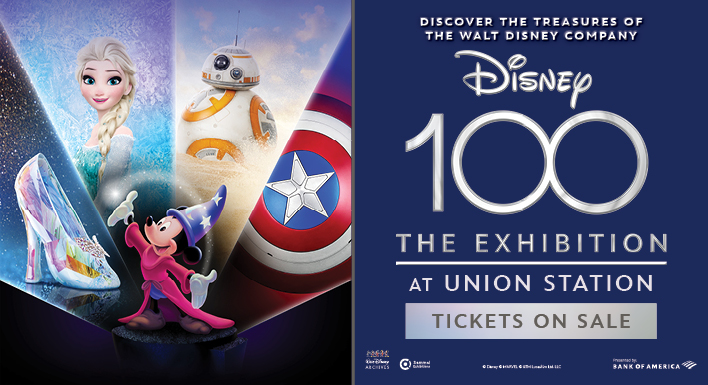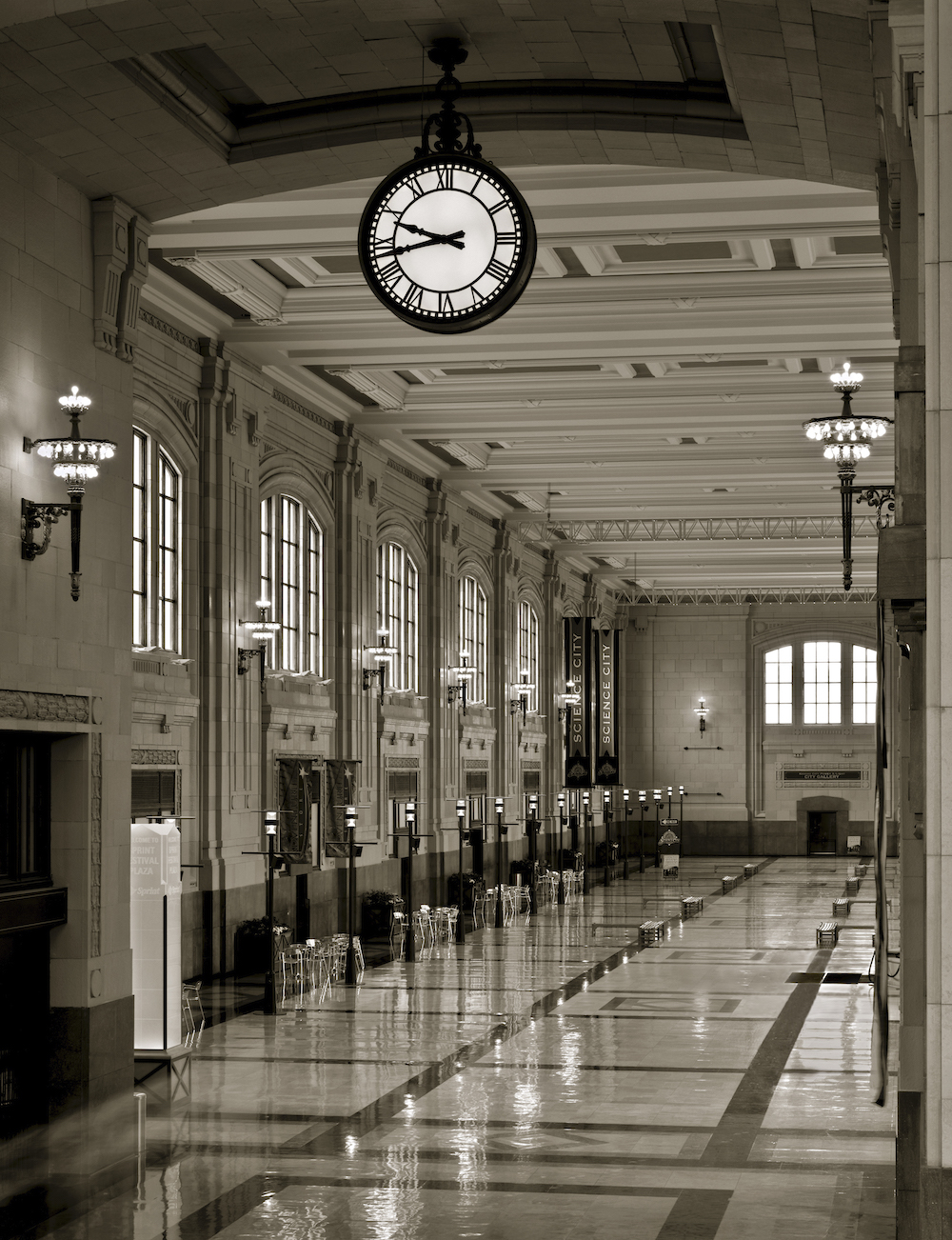Sure you can learn history from textbooks and videos. But when it comes to a landmark like Union Station, there’s no better way than talking with someone who was there. Sadly, finding Kansas Citians that remember our earliest days is getting harder and harder. So when you get to speak to one, never turn down the opportunity!
That’s precisely why we sat down with an expert that has rarely missed a day of work since the first train left in 1914! See if you can find them on your next visit to Union Station.
So tell us a bit about yourself and how you came to know Union Station.
I came in from Chicago around 1914. I spent a lot of time in a clock shop up there and was sent to Kansas City to continue operating. My first day on the job was October 30th, 1914. The station was packed with people all day, and just after midnight on November 1st, I watched the Missouri-Kansas Texas Flyer pull into the station.
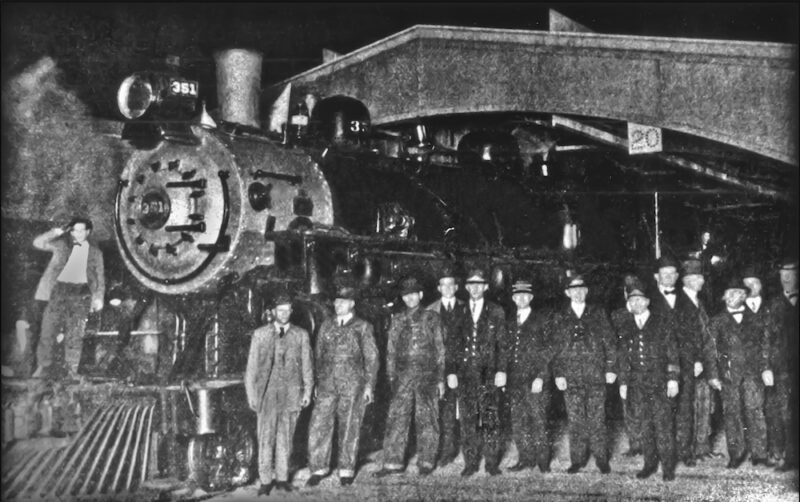
What was that atmosphere like?
It was electric! People came to the station for all sorts of reasons. Many of them couldn’t stop staring at the Edison bulbs in the chandeliers. In those days, electric bulbs were pretty rare in the home, which is why they’ll never cover those beautiful bulbs in a shade.
I even remember the first person to get a ticket. What a strange one he was! He staked his spot in line around 10 AM on October 29th and paid the next 20 people that showed up to let him buy the first ticket!
What other characters did you see in those days?
Well if you can call Theodore Roosevelt a character, I got a great look at him! In 1916, he visited to the tune of a 200-man band and we were at capacity. That was one of the first outings he had with his new, younger wife. So people were clamoring to see her just as much as him!
I was hanging around in February 1918, the morning Earnest Hemingway visited. He stopped to help a man with smallpox that a crowd had gathered around. I can still hear his voice saying “Who’ll help me get him out of here?” The crowd made way for him, and I watched Earnest pick him up and get in a cab with him heading to a hospital.
Union Station was the busiest I’ve ever seen during the great war. With over 270 trains in one day, we sent more people over there than most major stations in the US. I remember one couple in particular who couldn’t find anyone to take their picture, so they took photos of each other. Arthur Dutson and Kittie were their names.
Arthur proposed to Kittie in front of Union Station. But she turned him down because she didn’t want to become a war widow. When he returned through the station in 1919, her first word to him was yes. They came back to the station after they got married and I was always happy to greet them.
What was wartime like at Union Station?
Well, that’s where America coined the term “War Effort”. While our boys were fighting, we were putting in an effort. The station was business as usual in wartime. Both wars had a huge impact on Kansas City and the entire Midwest. But after the great war, I saw a spectacle I’ll never forget.
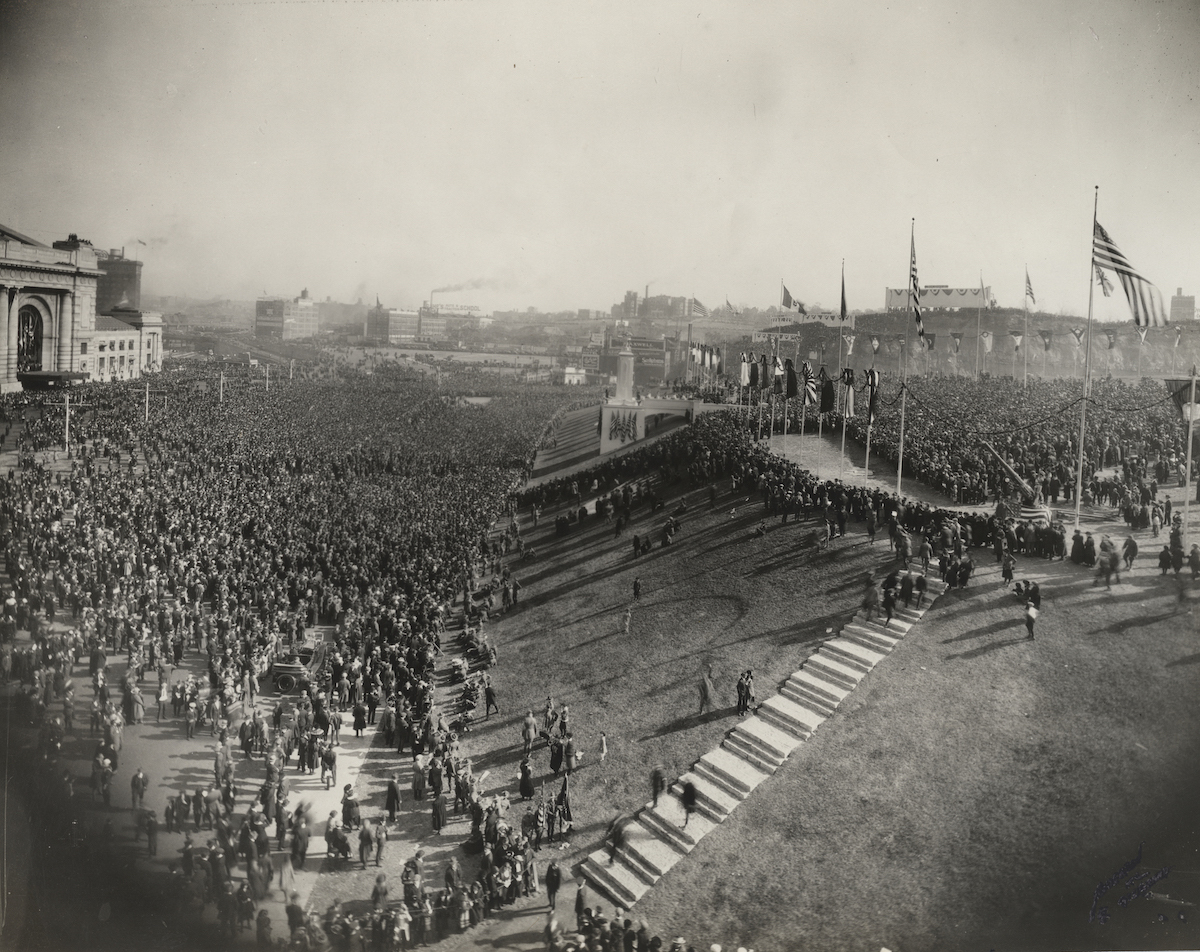
In 1921 all five Allied commanders came through our station for the site dedication of the Liberty Memorial. The day after General Pershing and Marshal Foch arrived the KC star read, “On Halloween night the gathering was counted not in the thousands but in the blocks.” The gathering essentially looked like what would happen if you combined all of the recent championship parades. If there was a party happening in Kansas City, it was usually at Union Station.
Can you tell us about those parties?
Well, I don’t remember much. But I know we all had a great time! An article in the Kansas City Star from January 1st, 1921, paints a great picture of how wild we got! The New Year’s celebration ended at the Union Station at about 7 o’clock in the morning. As far as could be determined only two fights took place. The police understood the fights were amongst friends, so they did not make arrests. At 6 o’clock in the morning the restaurants at the station were so crowded, people who desired to eat found it necessary to await their turn for tables or stools.
Did things ever get too out of hand?
Union Station is traditionally a safe place for families and friends to come together for their next great adventure. But in 1933, we had quite the scare. It’s no secret that mobsters of that time loved to hang out in Kansas City. Heck, I’m pretty sure I saw Capone pass through once or twice. Gangsters were just a fact of life in the city of fountains.
On June 17th, 1933, that started to change. Out front, Frank Nash was gunned down alongside the officers escorting him back to Leavenworth Penitentiary by rival mobsters. The sound of machine gun fire sounded like it was coming from inside the station and everyone was in a panic. This resulted in a citywide crackdown by the FBI, new federal laws, and the city becoming the center of national attention even before WWII.
How did Union Station change during WWII?
The Station was busier than ever! We didn’t have very many posters, but we had a booth that sold war bonds and I usually hung around two flags between the grand hall and the waiting room. The mailroom struggled to keep up, and red caps were few and far between. Since many of the able-bodied men were fighting overseas, we became one of the first stations to employ women in almost every position. Those ladies did their part by keeping the trains moving before and after the war. But when the war ended Union Station didn’t have any time to celebrate!
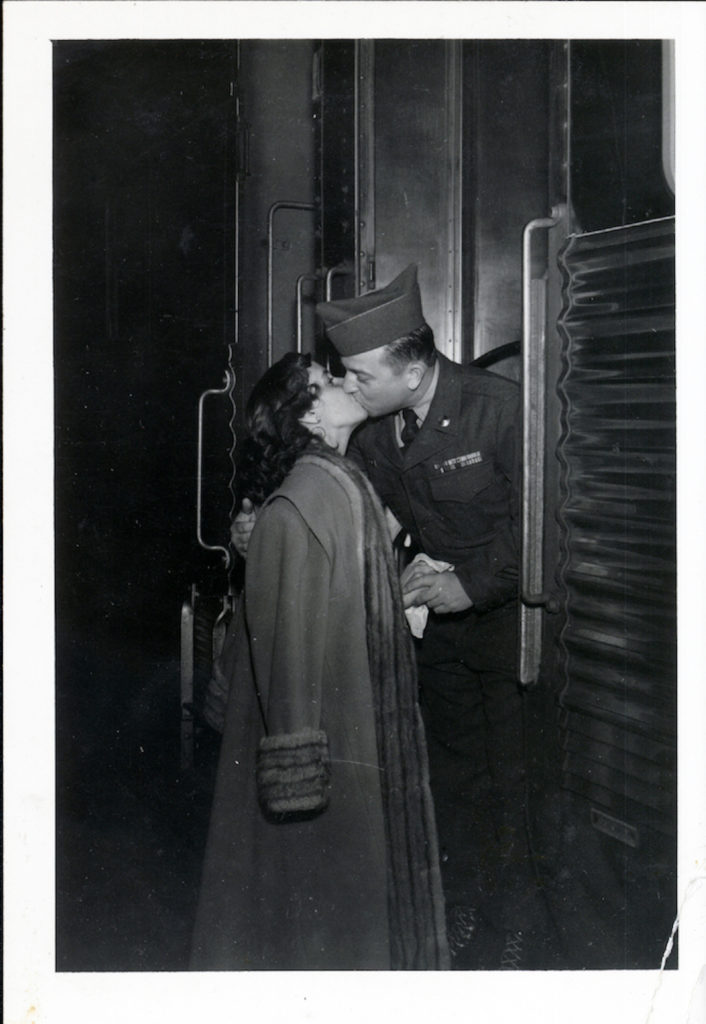
Why was that?
The day the war ended, Fred Harvey’s restaurant had a line out the door that stayed around 100 people long all day. We were also a major hub for soldiers and freed POWs coming home to the Midwest. That’s when we truly earned our title as a gateway to the Midwest.
Of all the people that came through the station, one couple stands out in my mind, Isak and Ann Federman. Isak was a prisoner of war from Poland that spent five and a half years suffering at various concentration camps in Germany. He escaped and met his wife Ann in a displaced person camp. When they came to America, social workers told them that Kansas City would help them “Americanize properly”.
What happened after they arrived?
As Isak and Ann stepped off the train I greeted them. Isak later said “We were scared, but I felt at home somehow. We lost that scaredness. After that, the Union Station, we were attached to it.” From that day, Isak became a bank chair and went into the investment business. Meanwhile, Ann focused on raising their two daughters and a son. Through all those years, they visited regularly and I was always there to greet the Federmans, their children, and their grandchildren.
That sounds like a movie! Has Union Station ever been on the big screen?
We have! In fact, Cecil B. DeMille, Walt Disney, and Judy Garland were some of our glitziest patrons in the glory days! I greeted Walt while he worked at Laugh-o-Gram down the street, and was always happy to see him after he started his own studio! Ms. Garland visited us while starring in a film about the real-life Harvey Girls.
Who were the Harvey girls?
When Fred Harvey started serving rail riders, he needed waitresses in the food cars, and the restaurant in Union Station. He originally hired men, but those fellas were a rough breed and that didn’t last long. Fred thought that conservative uniforms and good-natured girls would be the servers he was looking for.
Were they?
Well, sort of. Harvey girls were really popular on and off the rails. So popular in fact I remember Will Rogers saying, “Harvey and his young waitresses kept the west in food and wives”. After the Harvey girl heyday, it’s a safe bet that around 20,000 of those women wound up as brides for cowboys and railroad men. It’s also rumored that around 4,000 of the children from those marriages were named Fred, or Harvey. It may sound odd, but I recall greeting a lot more Harveys in the 50s than ever before!
How did Union Station Change in the 50s?
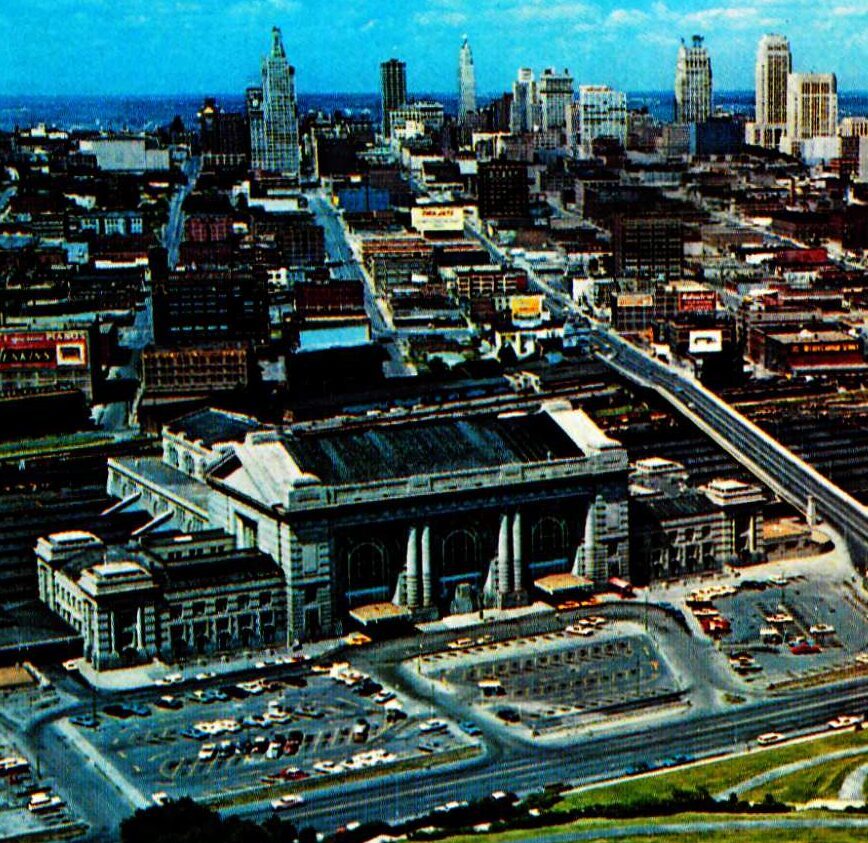
1947 was the last year I remember everything feeling right for a long, long time. Without the war traffic constantly coming and going, the station felt more like a cultural hub than one of travel. The loudspeakers played Bing Crosby’s White Christmas, choirs sang carols from the balconies, and people hurried around the station to get a shoe shine, hair trim, or a last-minute Christmas gift. But as air travel and road trips became more popular, Union Station started to lose its luster.
Did air travel start the decline?
Air travel may not have single-handedly started the Station’s decline, but it sure helped! Even with new trains, a freshly cleaned ceiling, and more shops than ever before, we just couldn’t keep up with the airport. I started to see fewer people in the ticket line. As people saw the USA in their Chevrolet, our train cars were becoming more empty by the day.
What did Union Station do to stay relevant?
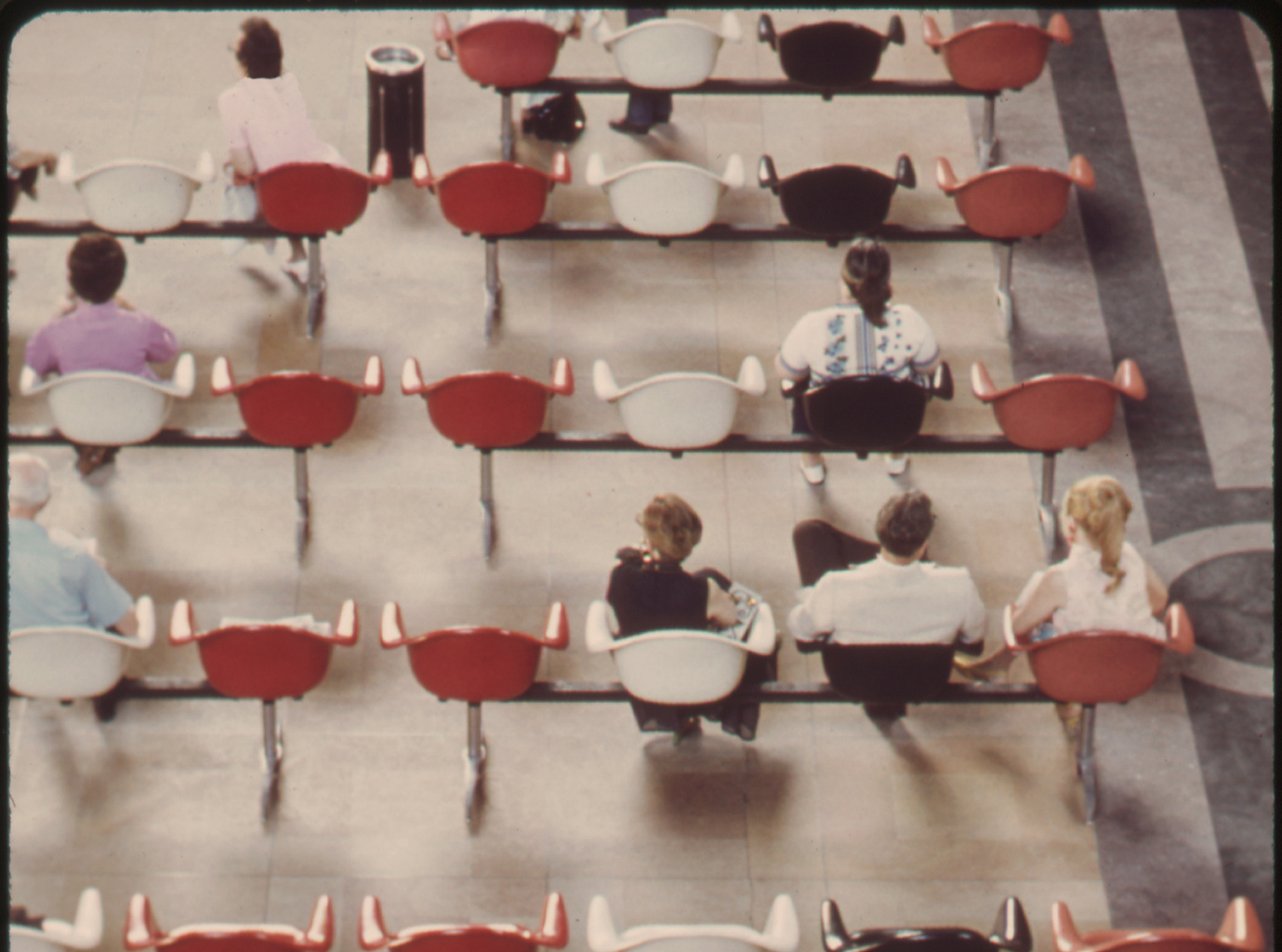
By the 60s, our halls looked very different than my first day. New escalators, events, and those ugly plastic chairs helped us cling to the changing times. But more roads, better cars, and faster planes made the station look like a fossil in a museum. In 1968, Vernon Coe even suggested that we focus our efforts on real estate instead of travel!
Is that when you started to take notice?
Well, I started to notice in 1958 when the Milwaukee line stopped service here. Ten years later Fred Harvey served his last plate in the station. By 1969 all twelve lines stopped service to Union Station. As the last KC Southern train departed, the station grew eerily quiet.
How did you keep morale going?
My job didn’t change much. But I started to see fewer visitors than ever before. The station found some success as a venue and office building in the 70s. We held a few antiques shows and even a cat show! But nothing drew very much attention and the city started to weigh its options about what could be done with the station.
What almost happened to Union Station?
President Coe almost got his wish. I remember him saying that the operating costs were no longer justified by the building’s use. This sent Kansas City into a tizzy. All those former Harvey Girls, war heroes, and Kansas Citians still had fond memories of the station in their hearts. In 71’ plans were drawn up to demolish the station and turn it into a high rise apartment complex.
We all remember what happened to Penn Station in New York, so I was relieved that Kansas City citizens fought to save the station. Citizens came out of the woodwork with all kinds of plans for the building. But George Erllich really got the ball rolling.
Who was George Erlich?
George helped found the Heritage and Preservation Council of Greater Kansas City. He also put together a symposium at UMKC to fight back against demolition plans. We were put on the national historic registry around that time, but that didn’t fully protect against demolition.
Because of George’s work, citizens formed a Save-Our-Station letter campaign. Mayor Wheeler even visited a few times with railroad execs to discourage them from demolishing the station. On July 1st 1974, the wheels finally started turning in the right direction for a comeback.
What did the public decide to do with Union Station?
After a huge auction in July of 76’ the halls were as bare as before we opened our doors. The original plan was to turn it into a shopping center and a science museum. But most proposals were lame ducks.
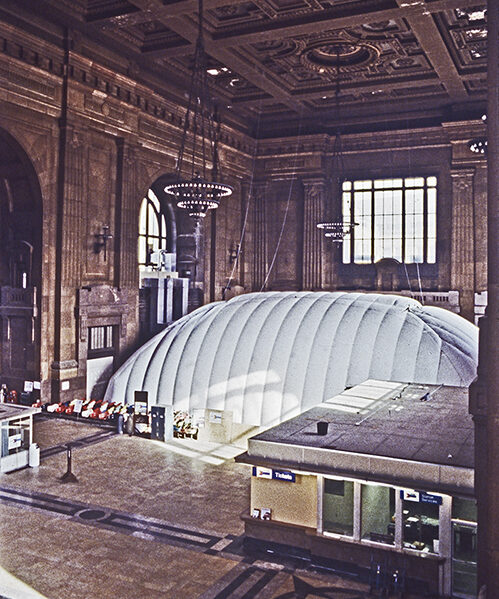
After the Lobster Pot closed, the last person I remember seeing in 1989 was Robert Gaines. He took a video of the disrepair. He documented the depressing state the station was in and I was in the final shot with my hands frozen at 12:40. After Robert left, the station sat empty. My only company was that of ghosts from adventures long ago.
So how did Union Station come back?
A lot of the legal action happened outside the station. But after a tax vote was held in the grand hall, Union Station started building steam again. I met Jack Dunforth as he campaigned for federal funding to restore the station and saw hundreds of Kansas Citians rallying out front.
What was the vote?
On November 5th, 1996 the bistate tax was approved and men in hardhats started showing up at the station shortly after. I grew accustomed to the silence from the last few years. But I was stirred awake again when jackhammers clanged and workers started pouring in.
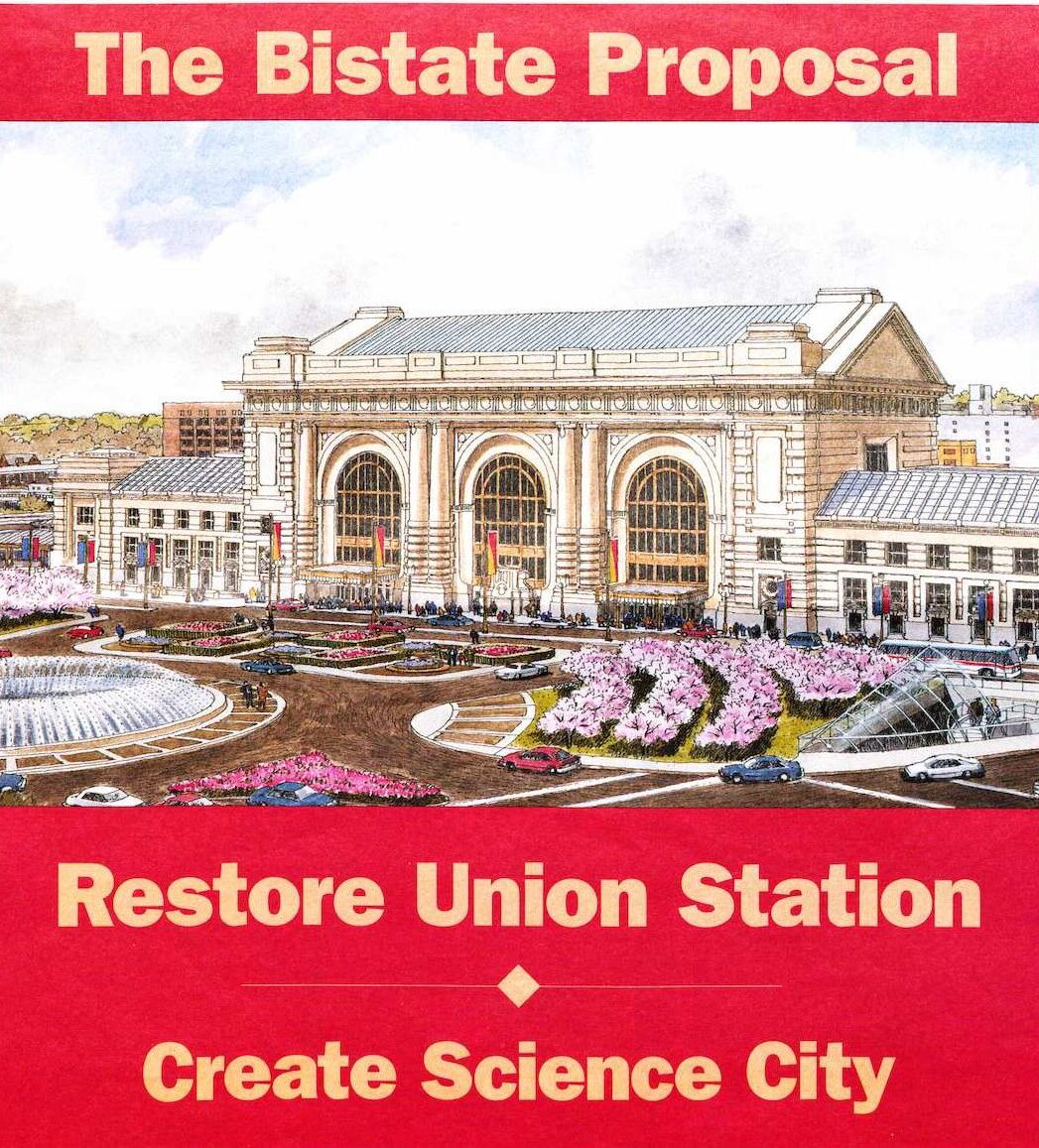
What all went into the reconstruction?
How would you like to spend a year 95 feet in the air covered in plaster? While it may not seem like your cup of tea, a small army of men greeted me every morning with smiles on their faces and tools in hand. Some of them really needed the work, so the project couldn’t have come at a better time for everyone!
I remember Julian Davis, or “Chewie” as the station knows him. He was a wild child that dropped out of school at 16 and went on to become quite the accomplished plaster master. He’s the reason that the ceiling is so intricate and true to its original form.
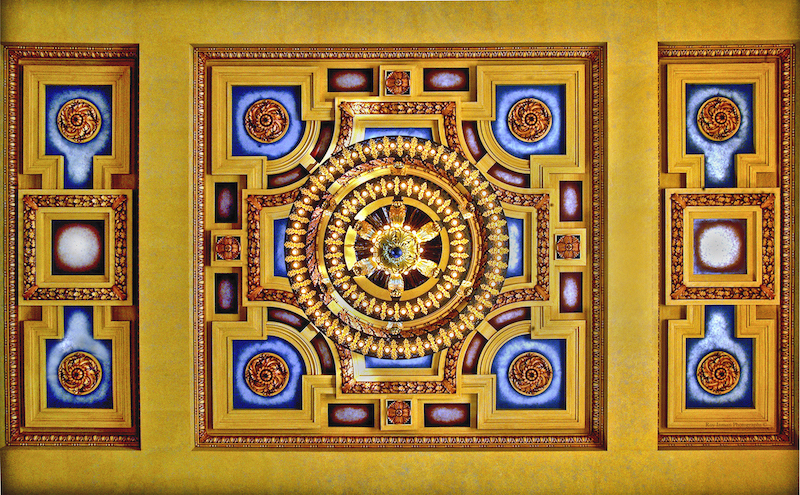
Even after the crew finished the first round of plastering, Chewie noticed that something was off. He looked at me, back to his crew, and he demanded that they all be redone. Julian measured everything laser straight to original specs and often muttered to himself on the job site.
What was your role in the restoration?
Well, I came down for the first time since 1914. Since I was supposed to be a permanent fixture, this task was quite daunting. Workers lowered me down 90 feet of scaffolding and onto a dolly where I was boxed up and left the station for the first time in history.
After a much-needed restoration, I got to see the city for the first time in 95 years. I visited more malls than Santa in 1999. You probably can’t tell from my face, but I was filled with gratitude and awe at how much Kansas City had changed since I got off that train from Chicago in 1914. I toured the city to get people excited about the reopening. But when it was time to get back to work, I came back to the station refreshed and ready for the next hundred years.
Would you like to tell the reader who you are?
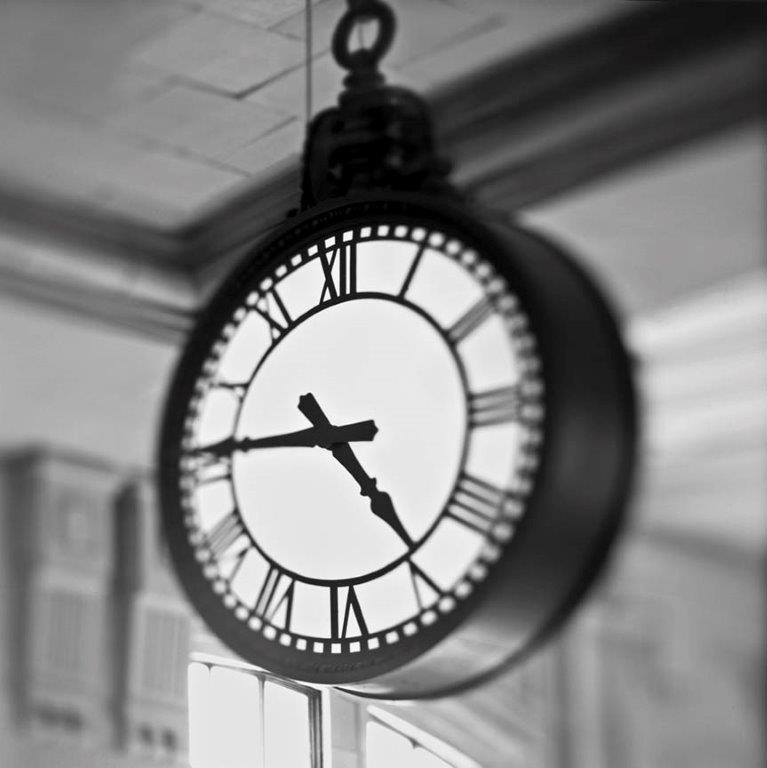
I’m the big ben of the plains of course! When you get your fill of the beautiful ceilings and amazing history just tell a friend to meet you under the clock, and I’ll be there too. I’ve been the life of every party at the station, and you can find me in music videos, TV shows, and almost any movie that takes place in Kansas City.
What’s your day-to-day like at the station now?
Well, the times may change, but my job hasn’t much. As a clock, I hang around the station to tell people the time whenever they decide to look up from their phones. But Union Station’s role has changed a lot since reopening.
How is that?
With the addition of Science City, the Reigner Extreme Screen Theatre, the Planetarium, and the City Stage Theater, the station is on a different track than ever before.
We’ve always been a hub for families and friends to gather before they depart for their next adventure. But now, we are the adventure! I get to greet school field trips and tour groups every day, and I still get to help travelers get to their train on time. The volunteers often love to reminisce about the old days, so every day I get to tell those stories alongside old friends while making new ones.
The station may have had its troubles, but we’re living proof that no matter what, Kansas City keeps hanging on. As long as Kansas City clings to Union Station, I’ll keep hanging around.
Come hang out with Ben at Union Station!
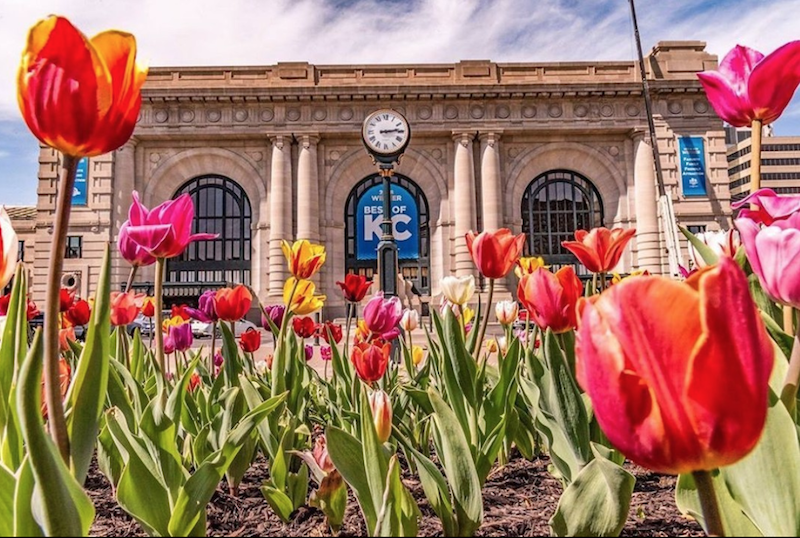
How’s that for a history lesson? While you may not be able to ask a clock these questions yourself, we hope you had fun learning about Union Station’s history from a first-person perspective 95 feet above it all.
When you’re ready to make history, start at the place with over a century of it. Plan your visit to Union Station and get your next adventure started on the right track! We’re excited to welcome you aboard.
Special thanks to the Missouri Valley Room for furnishing the research materials used in this passage.
